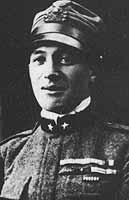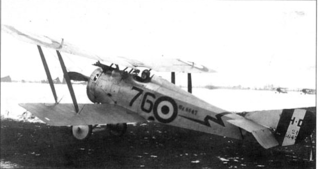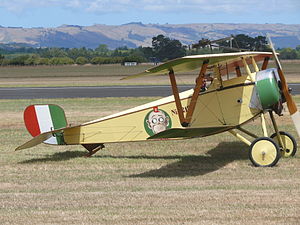
Flavio Torello Baracchini was an Italian World War I fighter ace credited with 21 confirmed and nine unconfirmed aerial victories. His confirmed victory total ranked him fourth among Italian aces of the war.
Sottotenente Michele Allasia was a World War I fighter ace credited with five aerial victories.

Maggiore Sebastiano Bedendo was a World War I flying ace credited with five aerial victories. After completing his education postwar, he rejoined Italian military aviation. He set several world aviation flying records with a Nuvoli N.5 monoplane before dying in an air crash.
Capitano Giulio Lega was a World War I flying ace credited with five aerial victories. After finishing the war, he completed medical school, and began a near lifelong career caring for the Italian Chamber of Deputies.
CapitanoGuido Masiero was a World War I flying ace credited with five confirmed and ten unconfirmed aerial victories. He was a prewar lancer who used his civilian engineering expertise to wrangle a transfer to aviation duty.

Amedeo Mecozzi was an Italian fighter ace of World War I, a general of the Italian Regia Aeronautica and a military theorist credited as the founding father of the "Attack air force" doctrine, which made him a strong opponent to general Giulio Douhet's theories.
Tenente ColonnelloGiorgio Michetti was a World War I flying ace credited with five aerial victories.
Tenente-colonnello Alessandro Resch was an Italian World War I flying ace credited with five confirmed aerial victories. After surviving World War I, he would become a pioneering airline captain, flying 500,000 miles between 1928 and 1935. He would return to the Italian Air Force as a major in 1935, rising to tenente-colonnello by 1939. His participation in World War II is unknown.
Tenente Giovanni Sabelli was an Italian World War I flying ace credited with five aerial victories. At the start of World War I, he was already an experienced combat pilot.
Tenente Luigi Olivi (1894–1917) was an Italian World War I flying ace credited with six aerial victories. He won two awards of the Silver Medal for Military Valor and was killed in action.

Mario Stoppani was an Italian World War I flying ace credited with six aerial victories. His valor earned him two Silver awards of the Medal for Military Valor and the Russian Cross of St. George during World War I.

TenenteMario Fucini was a World War I flying ace who claimed credit for 13 aerial victories during the war; seven of these were confirmed in 1919.
Tenente Gastone Novelli was a World War I flying ace credited with eight aerial victories.

71a Squadriglia of the Corpo Aeronautico Militare was one of the original fighter squadrons of the Italian military. Founded on 30 January 1916 to fight in World War I, the squadron served until war's end. It flew almost 3,000 combat sorties in defense of Italy at a cost of six pilots killed, scored 17 victories, and produced two aces from its ranks.
77a Squadriglia was one of the first Italian fighter squadrons. After its founding on 31 May 1916, it began flying combat in July 1916, and would operate until the end of World War I. It was one of the squadrons drawn into late 1917's Battle of Caporetto, and forced to retreat after the Italian defeat. By the time the Austro-Hungarians sued for peace, 77a Squadriglia could count some 50 aerial victories scored in about 250 victories.

78a Squadriglia was one of the original Italian fighter squadrons of World War I, serving in combat from 29 June 1916 to 3 November 1918. They flew 4,770 combat missions and were credited with 88 aerial victories.
79a Squadriglia was one of Italy's first fighter squadrons. It served in combat during World War I from 13 January 1917 though war's end. It was credited with 47 aerial victories.

80a Squadriglia was an Italian fighter squadron founded in 1917 to serve in support of the Battles of the Isonzo in northern Italy. By war's end, it had been credited with 21 aerial victories without suffering any of its own personnel casualties.

81a Squadriglia was an Italian fighter squadron raised in March 1917 that served through the end of World War I. One of its aces, Flavio Baracchini, would become the first awardee of the Gold Medal for Military Valor. The squadron would be credited with 34 aerial victories, and suffer four dead. It ended the war with 28 aircraft on strength.

Squadriglia 91a was one of the later fighter squadrons that the Italian Army created, on 1 May 1917. Because it drew an experienced cadre of pilots from pre-existing 70a Squadriglia, the squadron scored 14 victories within its first month of flying combat. As a result, it became known as "the squadron of aces". The new unit was immediately drawn into the ongoing Battles of the Isonzo in northern Italy. In September 1917, the squadron would serve as test pilots of the universally condemned SIA 7 multipurpose aircraft.










